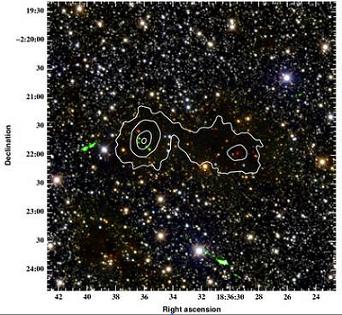Researchers examining archived data from a European Space Agency satellite, which operated in the mid-XNUMXs, this year looked with ground-based telescopes to regions where massive stars are born to reveal their secret

Scientists have been able to look for the first time at the birth of thousands of stars that are XNUMX times brighter than the Sun, thanks to the infrared observatory of the European Space Agency (ISO). The discovery allowed astronomers to begin investigating why so many of these large stars are born in certain regions of space.
Space is dotted with huge clouds of gas, occasionally areas within these clouds begin to collapse and form stars. One of the main questions in this field of research is why some clouds produce heavy stars and light stars while others only produce light stars? asks Oliver Kraus of the Max Planck Institute for Astronomy in Heidelberg and the Steward Observatory in Arizona.
The conditions necessary for the formation of heavy stars are difficult to detect because these stellar monsters form far from us and are hidden behind a cloud of dust. Only the long-wave infrared radiation can escape the nebulous cocoon and reveal the cold dust grains that mark the location of the star-forming region. ISO is trying to locate this radiation using its far infrared camera (far from the range of visible light).
The researchers used the camera's data to focus on the cold, dense cores that each contain enough material to produce at least one massive star. "This opens a new era of observations of the first details in the process of the creation of massive stars" said Kraus.
The data was collected by the ISOPHOT Serendipity Survey (ISOSS). In this study, the researchers noticed that when an ISO is turned from one celestial object to another, valuable observation time is lost. They organized a process for the far-infrared camera that would allow them to record non-stop even during the transmission of the data to Earth.
During the ISO mission that lasted two and a half years in the years 1995-1998, the spacecraft made about ten thousand rotations and provided a lot of data about the sky in a frequency window of 170 micrometers that had not been studied before. This wavelength is 310 times greater than optical radiation and it exposes dust at a temperature of ten degrees Kelvin. They created a catalog of these cold sites.
Birkman and his colleagues studied the Kaltog and found 50 potential areas where large stars might form. They then began an operation using ground-based telescopes and revealed that the object ISOSS J18364-0221 is actually two cold cores that look surprisingly like those in which small stars form but contained much more mass.
The first core is at a temperature of 16.5 degrees Kelvin and includes a mass 75 times greater than the Sun's identity and which showed signs of gravitational collapse. The second one is only 12 degrees Kelvin and has 280 solar masses. The team is currently looking at additional potential sites.
